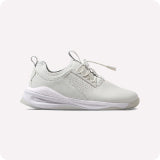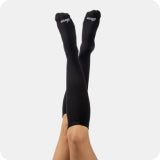Why Are My Feet Sore?
In a world where every step counts, the question "Why are my feet sore?" becomes more than just a whisper at the end of a long day. It's a shout from the depths of our daily routines, a puzzle we're all too eager to solve. As we embark on this journey together, remember you're not alone. Here, we stand (comfortably, thanks to Clove) ready to guide you through the common causes of foot soreness, empowering you with knowledge and solutions that stride with your well-being.
What are sore feet?
Foot soreness, an unwelcome companion for many, can turn simple activities into Herculean tasks. Whether you're a healthcare hero on the frontline or someone who loves jogging at dawn, sore feet can clip your wings. But don’t worry, understanding what causes sore feet is the first step to reclaiming your stride.
#1 Improper Footwear
At the heart of many aching feet lies a villain, often overlooked yet glaringly obvious: improper footwear. Ill-fitting shoes can have significant implications for foot health, leading to issues such as chronic foot pain, foot disorders, and even overall health. Research indicates that between 63% and 72% of individuals wear incorrectly sized footwear, which is associated with foot and knee pain and disorders like corns, calluses, and lesser toe deformities.
The wrong shoes can impact posture, mobility, and balance, and increase the risk of injuries like sprains, fractures, and musculoskeletal problems. Additionally, wearing ill-fitting shoes can lead to severe pain in the joints, nerve damage, and poor balance, affecting the feet, knees, hips, and back.
Choosing the Right Shoes
It is important to choose footwear that provides support and is comfortable to avoid these health issues. Selecting shoes with features such as adequate cushioning and the right fit around the toe and under the arches is essential to maintain foot health and overall well-being. If you find yourself asking, "Why do the soles of my feet hurt," seek out shoes with a sole that understands the importance of arch support, breathability, and that little extra cushion.
#2 Overuse and Strain
Overuse injuries in the feet and ankles are common and can result from repetitive stress and strain on these body parts. These injuries often develop gradually over time due to activities like standing for extended periods, running, or engaging in high-impact sports. Overuse injuries such as tendonitis, ruptured tendons, stress fractures, plantar fasciitis, Achilles tendinitis, neuromas, metatarsalgia, sesamoiditis, shin splints, and instability in the ankles can cause significant foot pain.
These conditions are prevalent not only among athletes but also among individuals with professions that involve prolonged standing. The symptoms of overuse injuries may include heel pain, ball of foot pain, shin splints, and increased risk of sprains and stress fractures.
Prevention Tips
It’s key to recognize the signs of overuse injuries early on to prevent further damage and seek appropriate treatment from a podiatrist. Rest, proper footwear, orthotics for additional support, gradual training progression, and treatment are recommended to manage and recover from overuse injuries effectively. When you begin to constantly wonder “Why are my feet sore?” listening to your body, recognizing discomfort as a signal to slow down or rest, and seeking professional care when needed are essential steps in addressing possible overuse injuries in the feet and ankles.
#3 Foot Conditions
From the dreaded plantar fasciitis with its signature heel pain to the nuances of flat feet or high arches, foot conditions come in many forms but share one thing: they make life a tad more challenging.
Plantar Fasciitis and Other Conditions
Plantar fasciitis is a prevalent condition that causes heel pain due to inflammation of the plantar fascia, a band of tissue supporting the foot arch. It is often linked to factors like overuse, foot structure, footwear, and walking surfaces. Symptoms include gradual heel pain, especially in the morning or after periods of inactivity, which can worsen with certain activities. Treatment options for plantar fasciitis include stretching, physical therapy, icing, medication, rest, orthotics, shock wave therapy, and steroid injections. Other conditions like stress fractures and nerve compression can also cause heel pain and should be differentiated from plantar fasciitis through medical history and examination.
Addressing these foot conditions involves choosing shoes that align with your foot structure to promote harmony between your feet and footwear for optimal comfort and support.
#4 Injury
Life, in its unpredictable glory, sometimes throws a curveball our way in the form of sprains, strains, and other injuries. A twisted ankle or a strained muscle can bring our world to a halt, turning every step into a large effort.
Treatment and Recovery
The RICE method, which stands for rest, ice, compression, and elevation, is a widely recognized approach for treating minor soft tissue injuries like sprains, strains, and bruises. This is often effective in reducing swelling, easing pain, and promoting healing in the initial stages of an injury. Here is a breakdown of how to treat sore feet using RICE method:
- Rest: Immediately after a severe injury like an ankle sprain it is crucial to avoid using the injured area to prevent further damage. Resting allows the body time to recover and heal without aggravating the injury.
- Ice: Applying ice packs or cold therapy to the injured area helps reduce pain and inflammation. Ice should be applied for 15-20 minutes every two to three hours during the first 24 to 48 hours after the injury.
- Compression: Wrapping the injured area with an elastic bandage helps reduce swelling by providing support and limiting excessive blood flow to the injured site. The compression should be snug but not too tight to avoid interrupting blood flow.
- Elevation: Keeping the injured body part elevated above the heart level helps reduce swelling, throbbing, and pain by preventing excessive blood flow to the injury site. Elevation is recommended even when not icing the injury.
The RICE method is most effective when used immediately after a minor injury to help reduce pain, swelling, and inflammation. If there is no improvement or if the pain persists after a couple of days despite using the RICE method, seeking medical attention is advisable.
"Why are my feet sore?" is not just a question; it's a call to action. A reminder that in the hustle and bustle of life, our feet deserve attention and care. At Clove, we are committed to doing our part by crafting sneakers for men and sneakers for women that are not just a solution but a revolution in foot comfort, designed with you in mind. Because at the end of the day, every step should be a step forward, not a pain to endure. So, stride forth with confidence, knowing your feet are cloaked in comfort, ready to take on the world—one step at a time.
Sources:
- NIH. Incorrectly fitted footwear, foot pain and foot disorders: a systematic search and narrative review of the literature. https://www.ncbi.nlm.nih.gov/pmc/articles/PMC6064070/
- Manhattan Podiatry Associates. How Improper Footwear Can Play a Role in Foot Pain. https://www.manhattanpodiatry.com/blog/how-improper-footwear-can-play-a-role-in-foot-pain
- Nagy Footwear. Is an Overuse Injury Causing Your Foot Pain? https://www.nagyfootcare.com/blog/is-an-overuse-injury-causing-your-foot-pain/
- American Academy of Family Physicians. Plantar Fasciitis and Other Causes of Heel Pain. https://www.aafp.org/pubs/afp/issues/1999/0415/p2200.html



